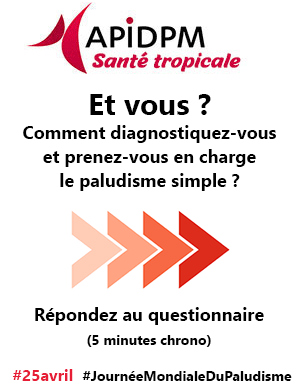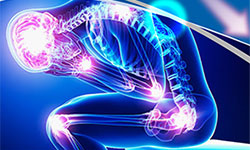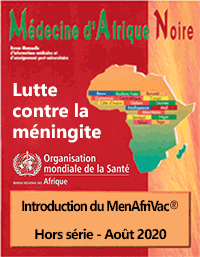
Le guide de la médecine et de la santé
en Afrique francophone
Suivez-nous :
 Identifiez-vous | Inscription
Identifiez-vous | Inscription

Suivez-nous :
 Identifiez-vous | Inscription
Identifiez-vous | Inscription

Publié dans Médecine d'Afrique Noire 6102 - Février 2014 - 95-104
 Etude des lésions hépatiques vues en échographie chez des patients symptomatiques à Pointe-Noire en 2012
Article Open access
Etude des lésions hépatiques vues en échographie chez des patients symptomatiques à Pointe-Noire en 2012
Article Open access
Auteurs : F. Bossali, L. Koumou-Okandzé, M. Bidounga, Kissama, J.B. Ognami, L. Diangouaya, J. Djamvou, P. Kalina, E. Makosso, J.R. Ibara - Congo-Brazzaville
Devant une symptomatologie abdominale non spécifique, l'échographie est l'examen de première intention à réaliser juste après l'examen clinique. L'objectif de notre travail a été de déterminer la prévalence échographique des lésions hépatiques à Pointe-Noire.
Méthodes : Etude transversale et descriptive, réalisée du 16 juillet au 16 novembre 2012.
Résultats : Vingt-deux centres d'échographies ont été répertoriés, tenus par 5 radiologues, 2 hépato-gastro-entérologues et 8 médecins généralistes. Quatre cent cinquante-quatre patients ont été inclus ; 235 hommes (51,8%) et 219 femmes (48,2%) d'âge médian à 40 ans. Trois cent quatre-vingt-seize patients (87,2%) résidaient à Pointe-Noire, 5 patients (1%) provenaient de Brazzaville, 30 patients (6,8%) provenaient d'autres localités et 23 patients (5%) provenaient du Cabinda. Ils étaient 85 patients (12,7%) ouvriers ; 44 commerçants (9,7%) ; 45 élèves et étudiants (10%) ; 91 fonctionnaires (20%) ; 11 paysans (2,4%) et 153 patients sans emploi (33,7%). Cent soixante-dix-neuf patients (39,4%) consommaient de l'alcool ; 20 patients (4,4%) consommaient de l'alcool et du tabac et 255 patients (56,2%) n'avaient aucune intoxication. Quatre cent cinquante-deux échographies (99,6%) ont été prescrites par les médecins contre 2 échographies (0,4%) prescrites par des agents de santé paramédicaux.
Les indications ont été les suivantes : portage d'hépatite B ou C 27 patients (5,9%) ; Ascite 4 patients (0,8%); douleurs abdominales 324 patients (71,3%) ; anomalies biologiques 1 patient (0,2%) ; bilan d'extension 4 patients (0,8%) ; hépatomégalie 12 patients (2,6%) ; ictère 10 patients (2,2%) ; hémorragie digestive 10 patients (2,2%) ; syndrome infectieux 12 patients (2,6%) ; traumatisme abdominal 3 patients (0,6%) ; splénomégalie 2 patients (0,4%) et dyspepsie 35 patients (7,7%).
Quatre cent cinquante-quatre échographies ont été réalisées : 262 normales (57,7%) ; lésions du foie 130 patients (28,6%) dont 3 abcès ; 10 CHC ; 18 cirrhoses ; 20 hépatites chroniques ; 9 hépatites aiguës ; 12 cholécystites lithiasiques ; 1 lithiase du cholédoque ; 1 pancréatite aiguë biliaire ; 22 stéatoses. Soixante-deux patients avaient des lésions d'autres organes (13,6%). Les facteurs étiologiques identifiés étaient : alcool 49 patients (37,6%); virus 17 patients (13%) et médicament 1 patient (0,7%). Chez 19,5% des cas les examens complémentaires demandés après l'échographie n'étaient pas disponibles et 11% des malades n'avaient pas accès au traitement proposé après l'échographie.
Conclusion : Sur 454 échographies réalisées à Pointe-Noire en 2012, les lésions hépatiques ont été retrouvées dans 28,6% de cas. La stéatose hépatique, les hépatopathies chroniques, les tumeurs et les lithiases biliaires étaient les lésions dominantes. Dans 19,5% des cas les examens complémentaires proposés après l'échographie n'étaient pas disponibles et dans 11% des cas les malades n'avaient pas accès au traitement proposé après l'échographie. Nos résultats révèlent les limites d'une prise en charge optimale des maladies du foie à Pointe-Noire.
For non-specific abdominal symptomatology, ultrasound is the first-line examination to carry out just after clinical examination. The objective of our study was to determine the ultrasound prevalence of hepatic lesions in Pointe-Noire.
Methods: Cross-sectional and descriptive study carried out from July 16th to November 16th, 2012.
Results: Twenty-two ultrasound centers were recorded, run by 5 radiologists, 2 hepato-gastroenterologists and 8 general practitioners. Four hundred and fifty four patients were included: 235 men (51.8%) and 219 women (48.2%) with a mean age of 40 years. Three hundred and ninety six patients (87.2%) lived in Pointe-Noire, 5 patients (1%) came from Brazzaville, 30 patients (6.8%) came from other localities and 23 patients (5%) came from Cabinda. Eighty-five patients (12.7%) were workers; 44 retail traders (9.7%); 45 pupils and students (10%); 91 civil servants (20%); 11 farmers (2.4%) and 153 unemployed (33.7%). One hundred and seventy nine patients (39.4%) drank alcohol; 20 patients (4.4%) drank alcohol and smoked and 255 patients (56.2%) had no intake of either. 452 ultrasounds (99.6%) were prescribed by doctors compared to 2 ultrasounds (0.4%) prescribed by paramedics. The indications were as follows: carrying hepatitis B or C: 27 patients (5.9%); ascites: 4 patients (0.8%); abdominal pains: 324 patients (71.3%); laboratory abnormalities: 1 patient (0.2%); disease staging: 4 patients (0.8%); hepatomegaly: 12 patients (2.6%); jaundice: 10 patients (2.2%); gastrointestinal bleeding: 10 patients (2.2%); infectious syndrome: 12 patients (2.6%); abdominal trauma: 3 patients (0.6%); splenomegaly: 2 patients (0.4%); and dyspepsia: 35 patients (7.7%). Four hundred fifty four ultrasounds carried out: 262 normal (57.7%); 130 patients with liver lesions (28.6%); 3 abscesses; 10 HCC; 18 cirrhosis; 20 chronic hepatitis; 9 acute hepatitis; 12 lithiasis cholecystitis; 1 cholelithiasis; 1 biliary pancreatitis; 22 steatosis. Sixty-two patients had lesions in other organs (13.6%). Etiological factors identified were: alcohol in 49 patients (37.6%); viruses in 17 patients (13%); medication in 1 patient (0.7%). In 19.5% of cases, additional examinations to be carried out after ultrasound were not available and in 11% of cases, patients do not have access to the proposed treatment.
Conclusion: Of 454 ultrasounds carried out in Pointe-Noire, hepatic lesions were found in 28.6% of cases. Hepatic steatosis, chronic hepatopathy, tumors and biliary lithiasis are the dominant lesions. However, in 19.5% of cases, additional examinations to be carried out after ultrasound were not available and in 11% of cases, patients do not have access to the proposed treatment. Our results reveal the limitations to the optimal management of liver diseases in Pointe-Noire.
 Lire l'article (PDF)
Article Open access
Lire l'article (PDF)
Article Open access
Cet article est actuellement coté ![]() (1,0 étoiles) par les abonnés de APIDPM Santé tropicale.
(1,0 étoiles) par les abonnés de APIDPM Santé tropicale.
Il a été consulté 3497 fois, téléchargé 43 fois et évalué 1 fois.
Retour - Sommaire de ce numéro









![]() Adresse
Adresse
![]() Téléphone
Téléphone
Revue MAN
Revue OST
Actualités
Webinaires
Espaces labos